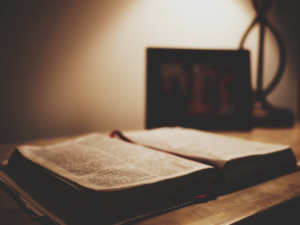
In this era of artificial intelligence and quantum chip supercomputers it is assumed that there is no mathematical solution that cannot be solved. In fact there is a proposed supercomputer that will be six billion times faster than a Cray-1. So, could the birth of Jesus Christ have been calculated? Could the event of His birth be mathematically simulated? Just how precise is God?
There is a mathematical hint given to us in Matthew 1:17,
“ So all the generations from Abraham to David are fourteen generations; and from David until the carrying away into Babylon are fourteen generations; and from the carrying away into Babylon unto Christ are fourteen generations.”
What we find is there is a watermark of God in Scripture, and it is…..a seal of 7.
In the Bible you will find over 600 passages with 7’s in it. Some are overt, others are structural, and others are hidden. What was first discovered by Dr. Ivan Panin (1885-1942) in the early 1900s and is now universally accepted is that there is a heptadic structure that is found in the Bible in both testaments when analyzing the Old Testament in Hebrew, and the New Testament in Greek. What does heptadic mean? It refers to a heptad or seven-fold basis or structural foundation….a numeric structure found in the text of the entire Bible. Does this work with any other books written in Hebrew or Greek? No.
Also interesting: Greek and Hebrew are the only two languages that have a numeric value assigned to each letter.
Given the current season, the most poignant and obvious example to consider is that of the birth of our Lord Jesus Christ almost 2,000 years ago. Let us consider the genealogy of Christ found in Matthew 1:1-17 which I encourage you to review in your Bible.
Do you think it would be possible to simulate the genealogy of Jesus from “scratch” using the same parameters found in Scripture? How would we go about creating a genealogy that would match the variables found in His?
Let’s start. Here is the formula:
The total number of words in this genealogy must be divisible by 7, evenly. That is, with no remainders.
The number of letters must also be divisible by 7, evenly. A little more difficult.
One rule of 7 is that you have only one chance of winning and six chances of failure.
But if you have two rules that is one chance in 7 squared or 49 chances. That is, by randomness you have one chance in 49 that it comes out in the solution desired. Do you see where this is going?
Also, bear in mind this has to be composed in Greek! And the Greek language is a highly inflective language. Every Greek word has to meet or communicate five conditions. It is much more constructive than our English language and with much greater range and latitude in its meaning. In other words, Greek has properties inherent to it that make it almost unsimulatable even with the aid of a computer. To simulate something means to imitate the appearance or character of.
Let’s keep going
The number of vowels and number of consonants must both be divisible by 7.
The number of words that begin with a vowel must be divisible by 7.
The number of words that begin with a consonant must be divisible by 7.
The number of words that occur more than once must be divisible by 7.
The number of words that occur in more than one form must be divisible by 7.
Those words that occur in only one form must be divisible by 7.
The number of nouns shall be divisible by 7.
Only 7 words shall not be nouns.
The number of names shall be divisible by 7.
Only 7 other kinds of nouns are permitted.
The number of male names shall be divisible by 7.
The number of generations shall be divisible by 7.
And this is the genealogy of Jesus Christ as found in Matthew 1:1-17. These 16 verses meet all of these rules in the Greek New Testament.
You can’t imagine composing this by yourself, right? Especially in Greek which is so rigid.
The chances of this happening by statistical accident are phenomenal or that is, highly unlikely.
For 2 7² = (7X7) 49
For 3 7³ = (7X7X7) 343
For 4 73 = (7X7X7X7), etc 2,401
For 5 75 = 16,807
For 6 76 = 117,649
For 7 77 = 823,543
For 8 78 = 5,764,801
For 9 79 = 40,353,607
Once you understand the statistical behavior, the more rules there are, the more unlikely that it will come about except by deliberate design.
How could you meet the challenge of simulating a solution using these rules? Let’s consider your time needed to meet this challenge and use this to summarize your effort:
8 hours/day, 40 hours/week, 50 weeks/year = 2000 hours/year, or 120,000 minutes/year.
79 chances = 40,353,607 attempts @ average of 10 minutes/attempt=
403,536,070 minutes or 3,362 years!
But it gets worse! Were there just nine variables represented in the passages? No!
For in actuality there are a total of 34 variables of 7-fold solutions within these 16 verses. What does that look like?
For 10 710 = 282,475,249
For 11 711 = 1,977,326,743
For 12 712 = 13,841,287,201
For 13 713 = 96,889,010,047
For 14 714 = 678,223,072,849
For 15 715 = 4,747,561,509,943
For 16 716 = 33,232,930,569,601
For 17 717 = 232,630,513,987,207
For 18 718 = 1,628,413,597,910,449
For 19 719 = 11,398,895,185,373,143
For 20 720 = 79,792,266,297,612,001
For 21 721 = 558,545,864,083,284,007
For 22 722 = 3,909,821,048,582,988,049
For 23 723 = 27,368,747,340,080,916,343
For 24 724 = 191,581,231,380,566,414,401
For 25 725 = 1,341,068,619,663,964,900,807
For 26 726 = 9,387,480,337,647,754,305,649
For 27 727 = 65,712,362,363,534,280,139,543
For 28 728 = 459,986,536,544,739,960,976,801
For 29 729 = 3,219,905,755,813,179,726,837,607
For 30 730 = 22,539,340,290,692,258,087,863,249
For 31 731 = 157,775,382,034,845,806,615,042,743
For 32 732 = 1,104,427,674,243,920,646,305,299,201
For 33 733 = 7,730,993,719,707,444,524,137,094,407
For 34 734 = 54,116,956,037,952,111,668,959,660,849
For those with mathematical minds it looks like this:
734 = ~5.4 X 1028 tries would be needed.
There are ~3.15 X 107 seconds/year
If with the aid of a supercomputer you attempted 400 million tries per second?
At 4 X 108 tries/second, it would still take about
4.3 X 1012 computer years: which in simpler terms,
=1,000,000 supercomputers for 4,300,000 years to achieve this statistical outcome.
In other words, this genealogy as it is written, could not happen by randomness. And the entire Bible, all 66 books, are composed with this heptadic structure in the original Hebrew and Greek.
This tells us that not only did God give Moses the Torah, but He gave it to him letter by letter.
If you pull one letter or “jot or tittle” out of the equation, the heptadic structure fails mathematically.
“Seven times a day do I praise thee because of thy righteous judgments.” (Psalm 119:164)
The recurrence of the number (7)-seven – or an exact multiple of sevens – is found throughout the Bible and is widely recognized by Bible Scholars world-wide. Seven is also the number of completion. The Sabbath on the 7th day; the 7-years of plenty and the 7-years of famine in Egypt; the 7-priests and 7-trumpets marching around Jericho for 6-days but on the 7th-day, they marched 7-times around the same wall; the Sabbath Year (the 7th) of the land are well-known examples. Also, Solomon’s building the Temple for 7-years, Naaman’s washing in the river 7-times, and the 7-churches, 7-lamp stands, 7-seals, 7-trumpets, 7-bowls, 7-stars, and so on in the Book of Revelation, all show the consistent use of the number (7)-seven, from Genesis to Revelation. But why? And most importantly, How?
You ever hear the phrase, “you can’t make this up?” Well it definitely applies to your Bible!
What we find is that the amazing numerical properties of the Biblical texts – both in the Greek of the New Testament and in the Hebrew of the Old Testament, are not only intriguing to discover, they also demonstrate an intricacy of design, a web, if you will of mathematical tapestry, which testifies to a supernatural origin, inspiration and design by the will of a Divine Author.
The numeric text, that is the signature of God, proves beyond doubt that the Bible is supernatural. The Word of God is an immeasurable blessing to us, and there is absolutely nothing random about the Word!
As you celebrate the birth of our Lord and Savior this season, be reminded that the very day, hour and moment of His birth was perfectly planned and timed. Likewise, so shall the time of His return be a perfectly timed moment.
“The words of the Lord are pure words: as silver tried in a furnace of earth, purified seven times.” (Psalm 12:6)

 Most of us appreciate the tease of a good riddle. As an example, “Jim’s father has three sons: Snap, Crackle and ____? “ (See answer below.) Sometimes the answer is veiled within a set of facts, and in some cases their answer contains the solution for yet another riddle that lingers behind. Within the Bible there are riddles (i.e. the inscription prophecy of Zechariah 3:8-10) and other times we might view a matter as veiled, when the answer may be right in front of us.
Most of us appreciate the tease of a good riddle. As an example, “Jim’s father has three sons: Snap, Crackle and ____? “ (See answer below.) Sometimes the answer is veiled within a set of facts, and in some cases their answer contains the solution for yet another riddle that lingers behind. Within the Bible there are riddles (i.e. the inscription prophecy of Zechariah 3:8-10) and other times we might view a matter as veiled, when the answer may be right in front of us.